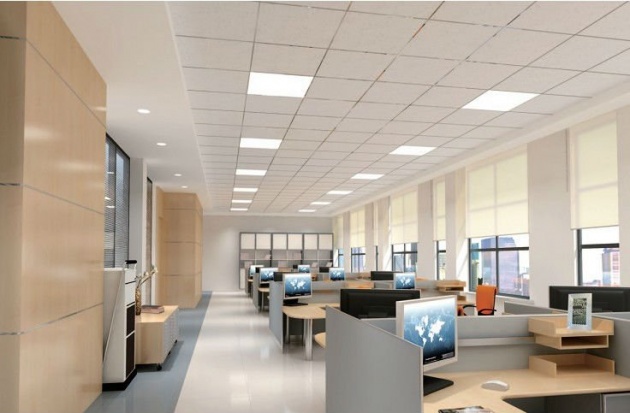Thanks to the LED revolution and a change in the way we use computers and screens, there has been a shift towards installing slimline LED panels in offices.
These are usually 600 x 600mm to fit into existing ceiling systems and deliver 3000-4000lm with a much reduced energy consumption, making them an attractive proposition to many office managers.
It used to be that plastic diffusers, either prismatic or opal, were the standard method of controlling light distribution from fluorescent fixtures. This was the case until codes for lighting offices demanded better control over light distribution. Plastic panels were replaced by aluminium reflector systems – and the era of the cat 2 louvre was upon us.
In light of these changes there is now sufficient confusion about the fire-rating requirements of the diffusing material of a luminaire to warrant a review of the current situation.
There are three possible conditions for thermoplastic (TP) diffuser material.
1. No rating at all
This is the most serious condition. If a luminaire specification does not carry any information about the fire-rating of its diffuser, it’s best to assume that it has no rating and avoid it.
The section on thermoplastic materials in the Fire Safety Part B document could be more helpful than it is currently written, but the general interpretation for the use of thermoplastic diffusers is as follows:
Ceilings of rooms and circulation spaces (but not including protected stairways) may incorporate thermoplastic lighting diffusers if ALL of the following provisions are observed:
a. The surfaces of the void space above the suspended ceiling comply with the general provisions that apply to the space below the suspended ceiling
b. TP(a) diffusers can be used without restriction
c. TP(b) diffusers are restricted as detailed below.
In other words, there is no provision in the UK Building Regulations for the use of non-rated thermoplastic panels. The situation is confused, however, by the number of luminaires currently available that use non-rated thermoplastic diffusers. Lux spoke to the Lighting Industry Association, the largest trade association in Europe, who told us:
‘The LIA position is that it is not illegal to sell a panel that is neither TP(a) nor TP(b) rated as long as it is clearly stated in the installation instructions that it cannot be used if it forms part of a ceiling. Panels that form part of a ceiling (ie recessed) must be either TP(a) or TP(b) rated and be installed in accordance with the Part B regulations relating to that rating.’
So this is a case of caveat emptor (buyer beware). Unless the manufacturer’s information states clearly that the luminaire being offered contains a diffuser that complies with either a TP(a) or TP(b) rating, DO NOT BUY IT.
2. TP(a) rating
Thermoplastic materials undergo specific tests to certify their ability to withstand the application of heat and fire. The requirements are established by Building Regulations Approved Document B, which sets out the fire safety of buildings. Section B2 covers internal fire spread.
TP(a) usually relates to polycarbonate diffusers with a thickness of at least 3mm. The testing procedure requires that the material self-extinguishes and any flaming and afterglow must not exceed five seconds once the source of flame is removed.
There is no restriction on the use of TP(a)-rated diffuser material.
3. TP(b) rating
TP(b) materials tend to be acrylic or polystyrene. It is a more problematic material because its use is limited by the extent of the installation. The testing for TP(b) requires a flame to be presented to the material. If the material combusts, the spread of flame must be no more than 50mm per minute – that’s 12 minutes to completely blanket a 600mm wide panel.
How the restrictions work in practice is as follows. In circulation spaces, the total area of diffuser panels must not exceed 15 per cent of the total floor area. The maximum area of one diffuser, or group of diffusers, must not exceed 5m x 5m. There must be a 3m spacing between each 5m x 5m diffuser grouping.

In offices and other rooms, the total area of diffuser panels must not exceed 50 per cent of the total floor space. The maximum permissible area of a single diffuser panel must not exceed 5m2. (This is a big luminaire and is most likely to occur as a rooflight detail.)
Where a conventional arrangement of luminaires is used, then either the arrangement for circulation spaces should be employed or else spacing between all luminaires should be no less than twice the diagonal distance (or diameter) of the luminaires in use.

TP(b) is a problematic material because it does catch fire, albeit in a ‘controlled’ manner. The total area of 5m2, for example, could be used to apply to a linear light channel measuring 100mm wide x 50m long. The material has the potential of spreading flame along its entire length over a period of only 20 minutes per metre. In a few hours, the lighting diffuser could spread its flame the length of an office corridor. This is a worrying prospect.

